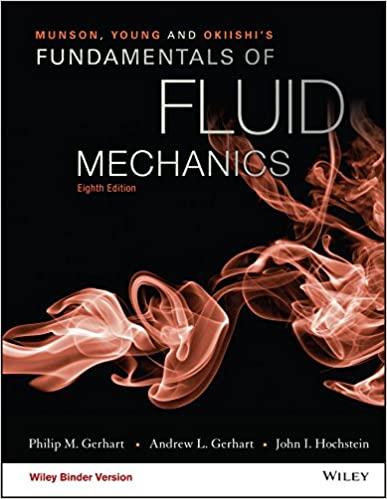Question
The mean blade radii of the rotor of a mixed flow turbine are 0.3 m at inlet and 0.1 m at outlet. The rotor rotates
The mean blade radii of the rotor of a mixed flow turbine are 0.3 m at inlet and 0.1 m at outlet.
The rotor rotates at 20,000 rev/min and the turbine is required to produce 430 kW. The flow
velocity at nozzle exit is 700 m/s and the flow direction is at 70 to the meridional plane. Determine the absolute and relative flow angles and the absolute exit velocity if the gas flow is 1 kg/s
and the velocity of the through-flow is constant through the rotor.
4. In a Parson's reaction turbine the rotor blades are similar to the stator blades but with the angles
measured in the opposite direction. The efflux angle relative to each row of blades is 70 from
the axial direction, the exit velocity of steam from the stator blades is 160m/s, the blade speed is
152.5 m/s, and the axial velocity is constant. Determine the specific work done by the steam per
stage. A turbine of 80% internal efficiency consists of 10 such stages as just described and
receives steam from the stop valve at 1.5 MPa and 300C. Determine, with the aid of a Mollier
chart, the condition of the steam at outlet from the last stage.
5. Values of pressure (kPa) measured at various stations of a zero reaction gas turbine stage, all at
the mean blade height, are shown in the table that follows:
Stagnation pressure Static pressure
Nozzle entry 414 Nozzle exit 207
Nozzle exit 400 Rotor exit 200
The mean blade speed is 291 m/s, inlet stagnation temperature 1100 K, and the flow angle at
nozzle exit is 70 measured from the axial direction. Assuming the magnitude and direction
of the velocities at entry and exit of the stage are the same, determine the total-to-total efficiency
of the stage. Assume a perfect gas with Cp 1.148 kJ/(kg C) and ? 1.333.
6. In a certain axial flow turbine stage the axial velocity cx is constant. The absolute velocities entering and leaving the stage are in the axial direction. If the flow coefficient cx /U is 0.6 and the gas
leaves the stator blades at 68.2 from the axial direction, calculate
(i) the stage loading factor, ?W/U2
;
(ii) the flow angles relative to the rotor blades;
(iii) the degree of reaction;
(iv) the total-to-total and total-to-static efficiencies.
The Soderberg loss correlation, eqn. (3.50) should be used



Step by Step Solution
There are 3 Steps involved in it
Step: 1

Get Instant Access to Expert-Tailored Solutions
See step-by-step solutions with expert insights and AI powered tools for academic success
Step: 2

Step: 3

Ace Your Homework with AI
Get the answers you need in no time with our AI-driven, step-by-step assistance
Get Started


